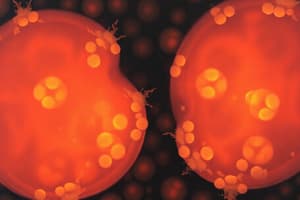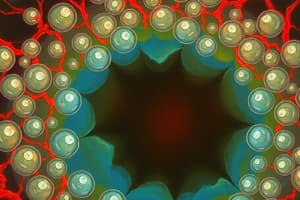Podcast
Questions and Answers
What is the primary difference between apoptosis and necrosis?
What is the primary difference between apoptosis and necrosis?
- Apoptosis is accidental cell death, while necrosis is programmed cell death.
- Apoptosis leads to tissue regeneration, while necrosis leads to cell replacement.
- Apoptosis involves rapid cell swelling and lysis, necrosis is controlled autodigestion.
- Apoptosis is a controlled process, while necrosis results from unfavorable conditions. (correct)
Which of the following cell types typically undergo apoptosis during development?
Which of the following cell types typically undergo apoptosis during development?
- All types of cells in the body
- Ovarian follicles
- Immature T lymphocytes (correct)
- Epithelial cells of the skin
What triggers the apoptosis of developing T lymphocytes?
What triggers the apoptosis of developing T lymphocytes?
- Natural cell programming (correct)
- Infection by pathogens
- External injury or trauma
- Overproduction of hormones
Which phenomenon is NOT an example of apoptosis?
Which phenomenon is NOT an example of apoptosis?
Which cells are primarily responsible for forming the framework of tissues and organs?
Which cells are primarily responsible for forming the framework of tissues and organs?
Which morphological characteristic is used to classify parenchyma cells?
Which morphological characteristic is used to classify parenchyma cells?
What distinguishes parenchyma cells from stroma cells?
What distinguishes parenchyma cells from stroma cells?
What is the role of apoptosis in relation to abnormal cells?
What is the role of apoptosis in relation to abnormal cells?
What is the primary function of the plasma membrane?
What is the primary function of the plasma membrane?
During which phase of the cell cycle does DNA synthesis occur?
During which phase of the cell cycle does DNA synthesis occur?
What is a key difference between mitosis and meiosis?
What is a key difference between mitosis and meiosis?
Which cytoskeletal component is primarily responsible for maintaining cell shape and rigidity?
Which cytoskeletal component is primarily responsible for maintaining cell shape and rigidity?
What occurs during the anaphase of mitosis?
What occurs during the anaphase of mitosis?
Which of the following cells are defined as 'rapidly renewing'?
Which of the following cells are defined as 'rapidly renewing'?
What describes the structural organization of microfilaments?
What describes the structural organization of microfilaments?
What characterizes the process of apoptosis?
What characterizes the process of apoptosis?
Which cell division process involves the separation of germ cells?
Which cell division process involves the separation of germ cells?
What is the function of ribosomes during cellular activities?
What is the function of ribosomes during cellular activities?
Flashcards
Cell
Cell
The basic structural and functional unit of living organisms, containing a plasma membrane, nucleus, and cytoplasm.
Cell Differentiation
Cell Differentiation
The process by which cells become specialized to perform specific functions, involving gene expression and organization into tissues.
Plasma Membrane
Plasma Membrane
A composed phospholipid bilayer containing cholesterol, proteins, and carbohydrates. Acts as a physical barrier, controls permeability, maintains gradients, and facilitates communication.
Cytoplasm
Cytoplasm
Signup and view all the flashcards
Rough Endoplasmic Reticulum (Rough ER)
Rough Endoplasmic Reticulum (Rough ER)
Signup and view all the flashcards
Smooth Endoplasmic Reticulum (Smooth ER)
Smooth Endoplasmic Reticulum (Smooth ER)
Signup and view all the flashcards
Golgi Apparatus
Golgi Apparatus
Signup and view all the flashcards
Lysosomes
Lysosomes
Signup and view all the flashcards
Peroxisomes
Peroxisomes
Signup and view all the flashcards
Mitochondria
Mitochondria
Signup and view all the flashcards
Ribosomes
Ribosomes
Signup and view all the flashcards
Cytoskeleton
Cytoskeleton
Signup and view all the flashcards
Microfilaments
Microfilaments
Signup and view all the flashcards
Intermediate Filaments
Intermediate Filaments
Signup and view all the flashcards
Microtubules
Microtubules
Signup and view all the flashcards
Nucleus
Nucleus
Signup and view all the flashcards
Apoptosis
Apoptosis
Signup and view all the flashcards
Parenchyma
Parenchyma
Signup and view all the flashcards
Study Notes
Cell Overview
- Basic structural and functional unit of living organisms.
- Smallest living parts of the body, comprising plasma membrane, nucleus, and cytoplasm.
Cell Differentiation
- Specialization process allowing cells to develop distinct functions.
- Involves gene expression related to cytoplasmic activities.
- Organized into tissues with specific functions and shapes.
Plasma Membrane
- Composed of a phospholipid bilayer with cholesterol, proteins, and carbohydrates.
- Functions include serving as a physical barrier, selective permeability, maintaining electrochemical gradients, and facilitating communication.
Cytoplasm
- Contains cytosol, a viscous fluid for organelle support and diffusion of solutes.
- Organelles perform specific metabolic activities essential for cellular function.
Cytoplasmic Organelles
- Rough Endoplasmic Reticulum (Rough ER): Modifies, transports, and stores proteins synthesized by ribosomes.
- Smooth Endoplasmic Reticulum (Smooth ER): Synthesizes lipids, metabolizes carbohydrates, and detoxifies drugs and poisons.
- Golgi Apparatus: Modifies, packages, and sorts materials from the ER; creates secretory vesicles and lysosomes.
- Lysosomes: Digest microbes or damaged cellular components through enzymatic action.
- Peroxisomes: Detoxify harmful substances, engaging in fatty acid metabolism.
- Mitochondria: Synthesize ATP via aerobic cellular respiration by converting glucose and oxygen.
- Ribosomes: Sites of protein synthesis, with bound ribosomes producing proteins for export and free ribosomes synthesizing proteins for internal use.
- Cytoskeleton: Provides structural support, aids organelle movement, and facilitates cell division and shape changes.
Cytoskeleton Components
- Microfilaments: Composed of actin, maintaining cell shape and supporting muscle contraction.
- Intermediate Filaments: Provide structural stability and support cell junctions.
- Microtubules: Organize cellular structure, transport organelles, and assist in cell division.
Nucleus
- Largest cell structure, containing the nuclear envelope, chromatin, and nucleolus.
- Houses genetic material, directing cellular activities and producing ribosomal units.
The Cell Cycle
- Series of events for cell proliferation, consisting of four phases:
- Mitosis: Cell division producing two identical diploid cells.
- G1 Phase: Gap between cell division and DNA synthesis.
- S Phase: DNA synthesis and replication occurs.
- G2 Phase: Gap before the next mitosis.
Mitosis Phases
- Prophase: Chromosomes condense; nuclear structures begin to dissolve.
- Metaphase: Chromosomes align at the equatorial plate.
- Anaphase: Centromeres split, ensuring equal genetic material distribution.
- Telophase: Chromosomes uncoil and the nuclear envelope reassembles.
Mitosis vs. Meiosis
- Mitosis results in 2 diploid cells; Meiosis results in 4 haploid gametes (eggs and sperm).
- Mitosis maintains chromosome number; Meiosis halves the chromosome number (23 pairs to 23).
Stem Cells
- Undifferentiated cells renewing differentiated tissues as needed.
- Characterized by asymmetric division; one daughter cell remains a stem cell.
- Progenitor cells are committed to differentiation.
Cell Population Types
- Rapidly Renewing: Cells dividing rapidly, e.g., blood cells.
- Stable: Cells dividing slowly and episodically, stimulated by injury, e.g., periosteal cells.
- Static: Non-dividing cells, e.g., CNS cells.
Apoptosis
- Highly regulated process of programmed cell death, eliminating defective cells without rupture.
- Examples include epithelial cells, T lymphocytes, and embryonic cells.
Apoptosis Examples
- Cells with preset lifetimes or those that need to be eliminated during development, e.g., webbed digits in embryos.
Cell Death Types
- Apoptosis: Physiological, controlled process; involved in development and tissue homeostasis.
- Necrosis: Accidental, pathological cell death due to unfavorable conditions.
Classification of Cells
- Parenchyma: Functionally specialized cells, main characteristic cells in an organ, e.g., hepatocytes in the liver.
- Stroma: Supporting, less specialized tissue; includes other cells and structural fibers.
Morphological Characteristics
- Parenchyma classification based on cell shape, arrangement, number, and location of nuclei.
Studying That Suits You
Use AI to generate personalized quizzes and flashcards to suit your learning preferences.




